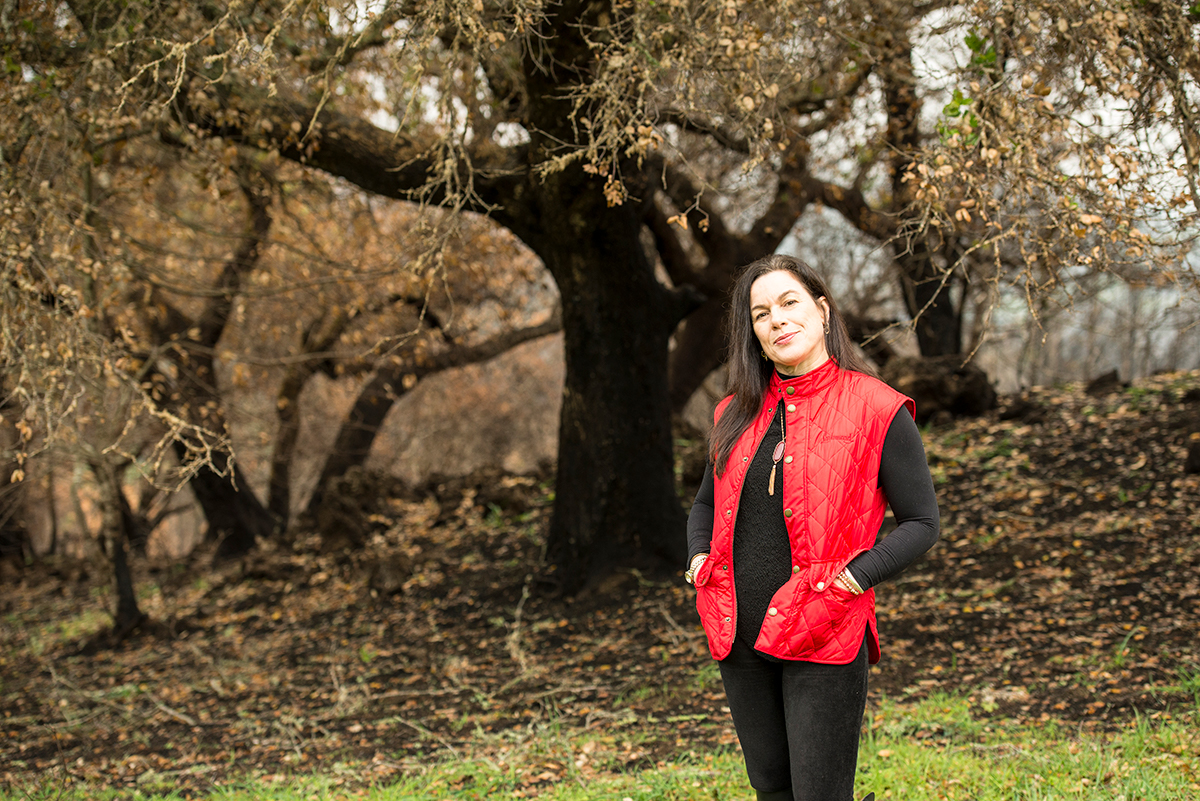erched on a ridgeline in the Mayacamas Mountains northeast of Santa Rosa, Pepperwood Preserve spans 3,200 acres, protecting the headwaters of three watersheds that feed the Russian River and offering refuge to more than 900 species of native plants and animals. President and CEO Lisa Micheli, who took the helm at Pepperwood in 2009, has led the private preserve’s transformation into “a field station of global significance” recognized by the National Science Foundation. More than a dozen research projects—studying anything from climate change and hydrology to grasslands and phenology—are underway at Pepperwood at any given time, while the preserve and its 9,400-square-foot Dwight Center for Conservation Science also serves as a lab and nature-education center for students and citizen scientists of all ages.
Research, teaching, and outreach have come together at the preserve under Micheli, who holds a civil engineering master’s in Environmental Water Resources and a Ph.D. in Energy and Resources, both from UC Berkeley. In recognition of Pepperwood’s commitment to world-class science, environmental education, and community involvement, Micheli has been named Bay Nature’s 2018 Local Hero for Environmental Education.
Bay Nature: Let’s start with the Tubbs Fire’s impact on Pepperwood. You’ve made wildfire mitigation a major focus of research at Pepperwood. In terms of recovery and then preparation for the next fire, is this an opportunity for land managers in the region to do some things differently?
Lisa Micheli: It’s almost like the clock is being reset on our forests, so we have this critical window to come in and start more aggressively managing them. At Pepperwood, we benefit from input from scientists and also from our Native American council, whose people used prescribed fire as a landscape management tool in our region for millennia. We are at the table with the decision-makers saying, “We need to start thinking of fuels management as another one of our objectives like ecology and water quality and property values.” For example, some of the erosion-control methods that people use have fuel-loading consequences. I think the lesson is that more than ever, we need to integrate environmental and natural-resource considerations into our emergency-response measures, before the emergency happens!
BN: How does that work fit into your broader objectives around climate-change research at Pepperwood?
LM: Our goal is to translate global science for local applications. Some of the work we’ve done with our science affiliates has been on the increased risk of fire and potentially increased fire intensity as a result of climate change. We’ve also been raising awareness about the likely increasing frequency of drought. Now we’ve experienced a record-breaking drought and this fire that moved at unprecedented speeds through our landscape. People are really looking to Pepperwood to help them interpret the science to understand these events, and the implications for land and water management. We’re one of the few organizations at the interface of trying to find the best science and sharing it in a way that people can understand it, to inform our conservation priorities right now, with immediate applications. Pepperwood as a science entity is different from a university or academic research center because our focus is on serving the open-space managers, owners, and stewards of our Bay Area region. We really are trying to listen to what they need.
BN: Yet as far as conducting long-term climate research across the Pepperwood landscape, you would seem to be contributing to a global knowledge base as well.
LM: That’s part of what we’re doing—making sure the data we collect here is fed into global databases, and then it’s available for work at multiple scales. And as an earth-science nerd, I find this work at multiple scales really compelling. So we have the data for understanding Pepperwood Preserve, or even a particular forest grove at the preserve, and yet our scientists are also contributing to analyses of trends across the globe over time.
BN: How does Pepperwood translate its science for students and other community members?
LM: What makes us different from many of our sister organizations is our science focus—and that we’re really trying to bring science to everyone in the community. Here in Sonoma County, 85 percent of our natural areas are privately owned, so we need everyone to be equally good stewards.
Our youth programs focus on raising the bar on science education and getting children out on the preserve, because even in the North Bay, many kids don’t necessarily have outdoor education opportunities. We help them perform better with respect to the state’s science standards tests and invite them to have a really welcoming relationship with nature, which can improve health and activity levels and empower them to feel safe and know how to handle themselves outdoors. I am especially proud that our youth and family programs are delivered in a bi-lingual English-Spanish format, and that we are committed to diversifying the pipeline of conservation professionals.
That whole bailiwick is the work of Sandi Funke, our education director. I have a long friendship and collegial relationship with Sandi. Before Pepperwood, we worked together at another nonprofit for about six years. We were really lucky that she came to Pepperwood. At the time we basically had a kids’ field-trip program and a college field-trip program, and she turned it around and said, “How can we really leverage the value of Pepperwood as an on-site learning center for everyone in our community?”
Nobody’s a hero by themselves. At Pepperwood we have educators participating in science projects, and scientists participate in education projects. We realized early on that we wanted to cross-fertilize.
BN: You’ve personally been involved in both research and outreach, as well as fundraising. How did you arrive where you are today, and what part of the job do you enjoy most?
LM: My path was quite meandering. As an undergraduate I was interested in physical oceanography and thought I was going to work on ocean science. But I had trouble picking one major, and I kind of wanted to do all the majors. I’ve always been interested in a developing a multidisciplinary perspective. I love science and I wanted to have science as a credential and work on that side of our environmental challenges, but I am not that good at specializing.
My first job out of college was at the San Francisco office of the Environmental Protection Agency. At age 23 I was running a four-state EPA wetlands enforcement program. That experience was such an important education in issues facing California’s environment, in people, in how decisions get made.
Building teams has evolved as my strength: helping to identify the right people and really listening closely to what they need. Science is a sweet spot for me, but as a manager I use the same skill set working across the entire Pepperwood team of 17 people, some of whom have biology degrees, education degrees, and have business and fundraising backgrounds. There is nothing quite as satisfying as seeing a terrific team all pulling together and making a real difference in our community and for our planet!





